There’s a part of Siem Reap that most people never see.
Many of those who visit Cambodia have only one thing on their agenda: the temples of Angkor Wat. It’s a UNESCO Heritage Site that draws more than 2 million tourists every year. There are day passes and even weekly passes, meaning some people visit Siem Reap and only ever visit the temples, never choosing to explore beyond what the guidebooks tell them.
I spent two weeks traveling in Cambodia, which is hardly enough time to really grasp the climate, but I did spend more than a year living and traveling around different parts of Asia. I genuinely believe that, by this point, I had had the opportunity to understand the direction and pace of life in this part of the world. I had seen both opportunity and poverty side by side, and had made local friends who helped me to comprehend what life in Asia is really like.
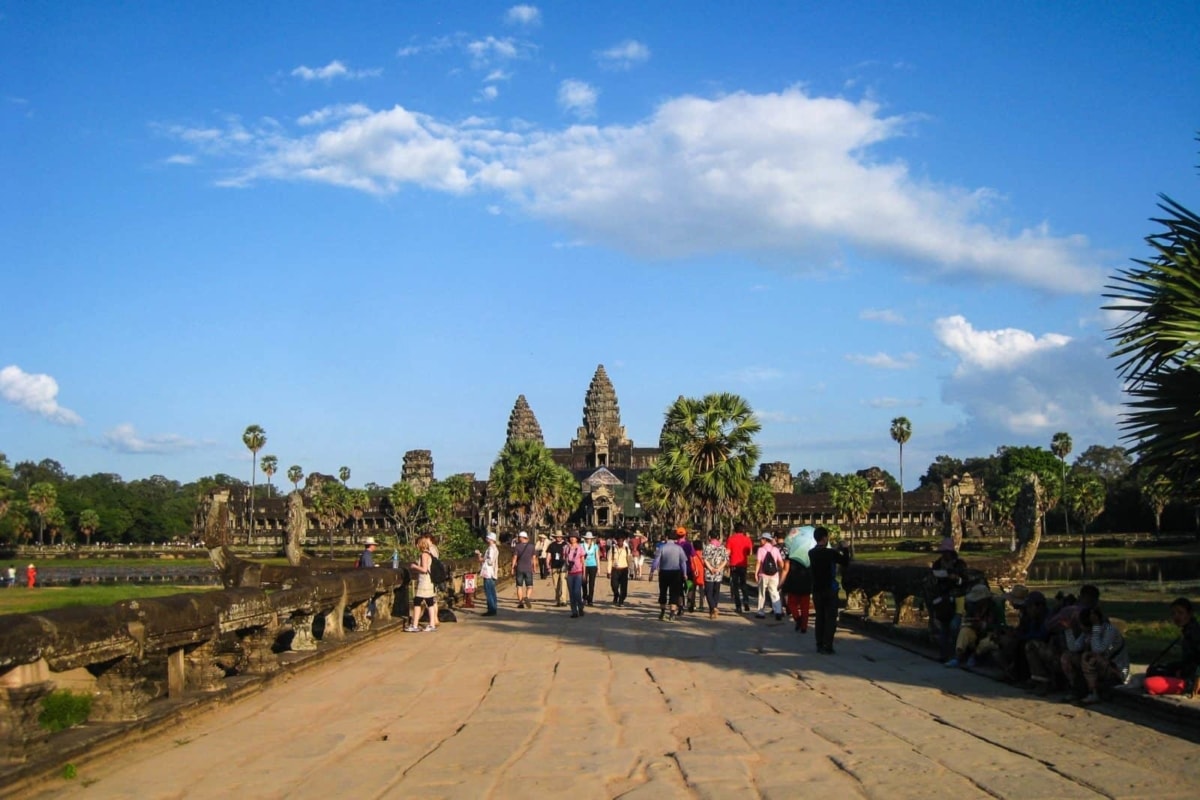
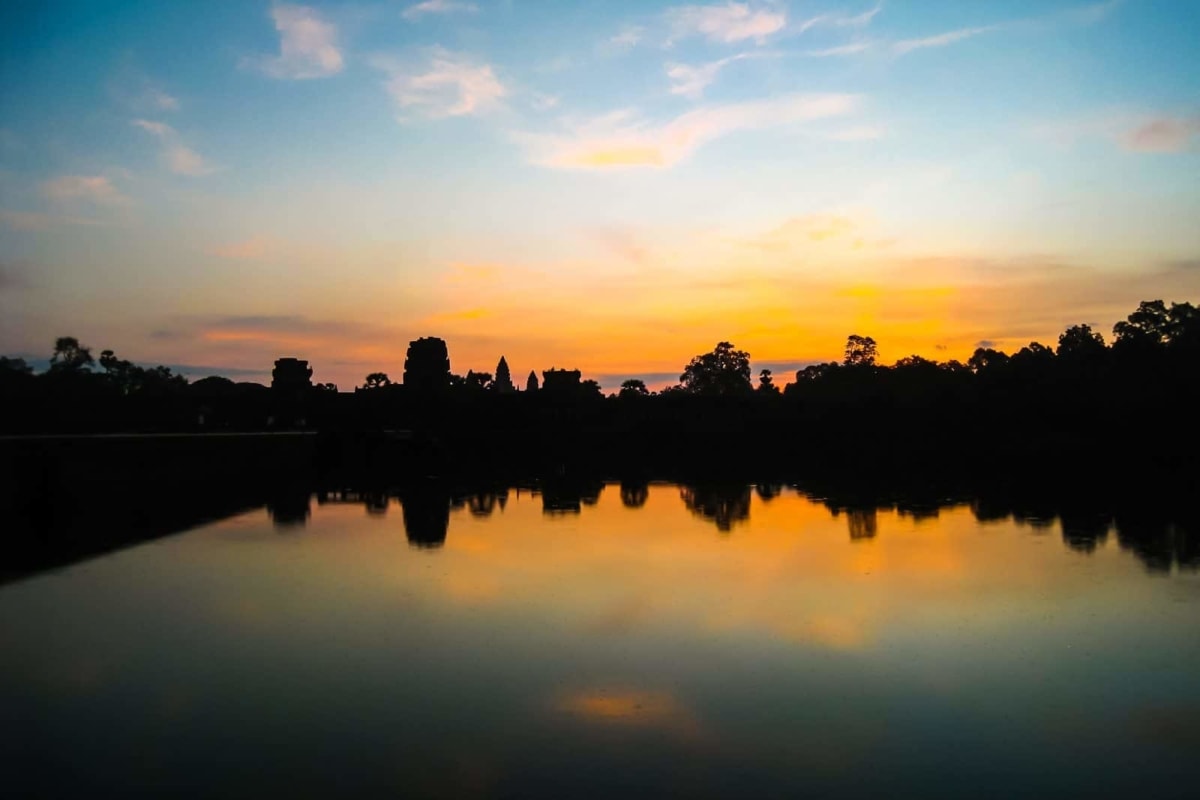
I’m not one for “typical” tourist activities. Whenever possible, I like to stray from the normal tourist path by trying to unearth a greater insight into what local life is like in any given community. I had heard about the floating Chongknease Village on the Tonle Sap Lake just outside the city of Siem Reap, so I arranged transport and a local guide.
To be honest, I hadn’t quite realized what I’d be seeing. I had not expected to come face to face with poverty; the type of poverty where people have no clean drinking water and people must evade the government in order to survive.
Being a Tourist in Cambodia
After having learned about corruption and abuse within the tourism industry in Thailand, I was sure to ask my guide all the appropriate questions about how the dollars I spent to see the village would contribute to the local community. He assured me that a large percentage of the price I paid would be given to the leader of the village, who would then decide how best to utilize the funds.
I couldn’t be sure if he was telling the truth, especially after coming face to face with deception and greed in Laos, but I took him at his word. I liked my guides. They were locals, too, and had grown up in the region.
One of them had actually spent his whole life learning English, just so he could make a living catering to the tourists.
Of course, a lot of people in Southeast Asia cater to the tourists. It is the largest industry there, and simply having white skin is grounds for becoming an immediate target. Later in the week, I would get pick-pocketed by a local prostitute, but that’s another story for another time.
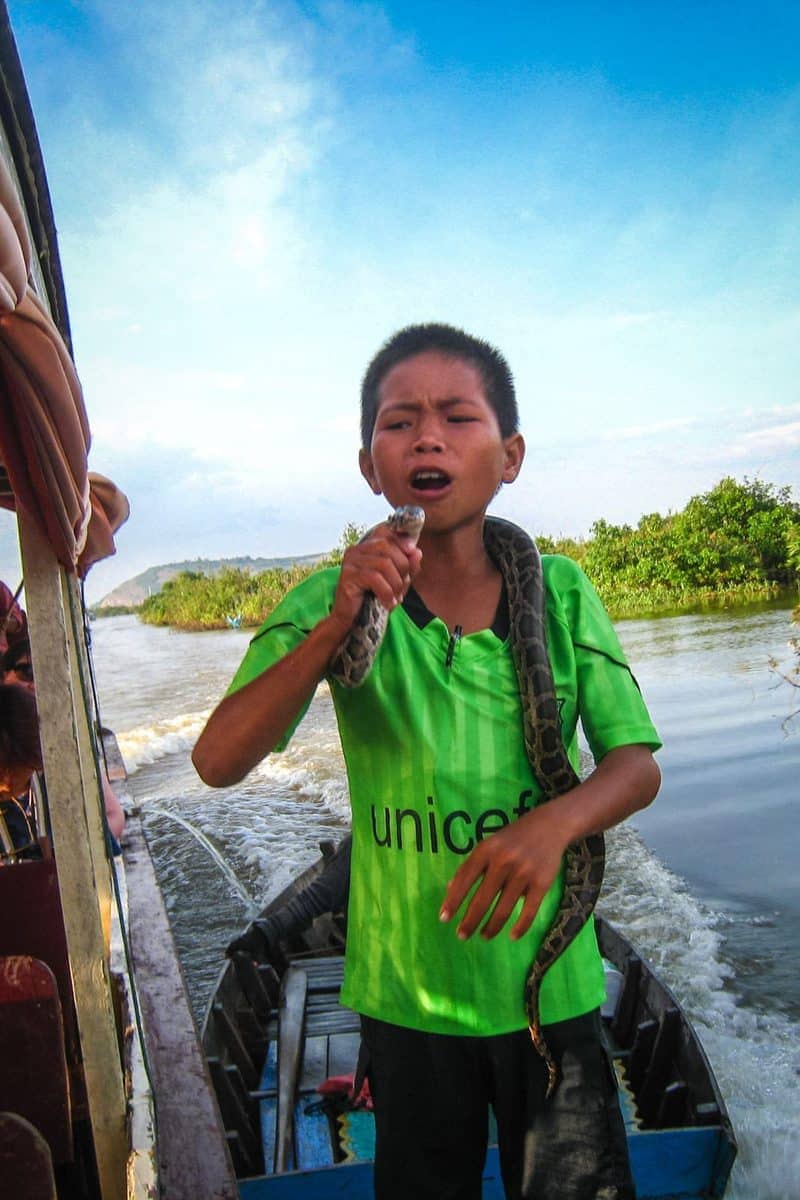
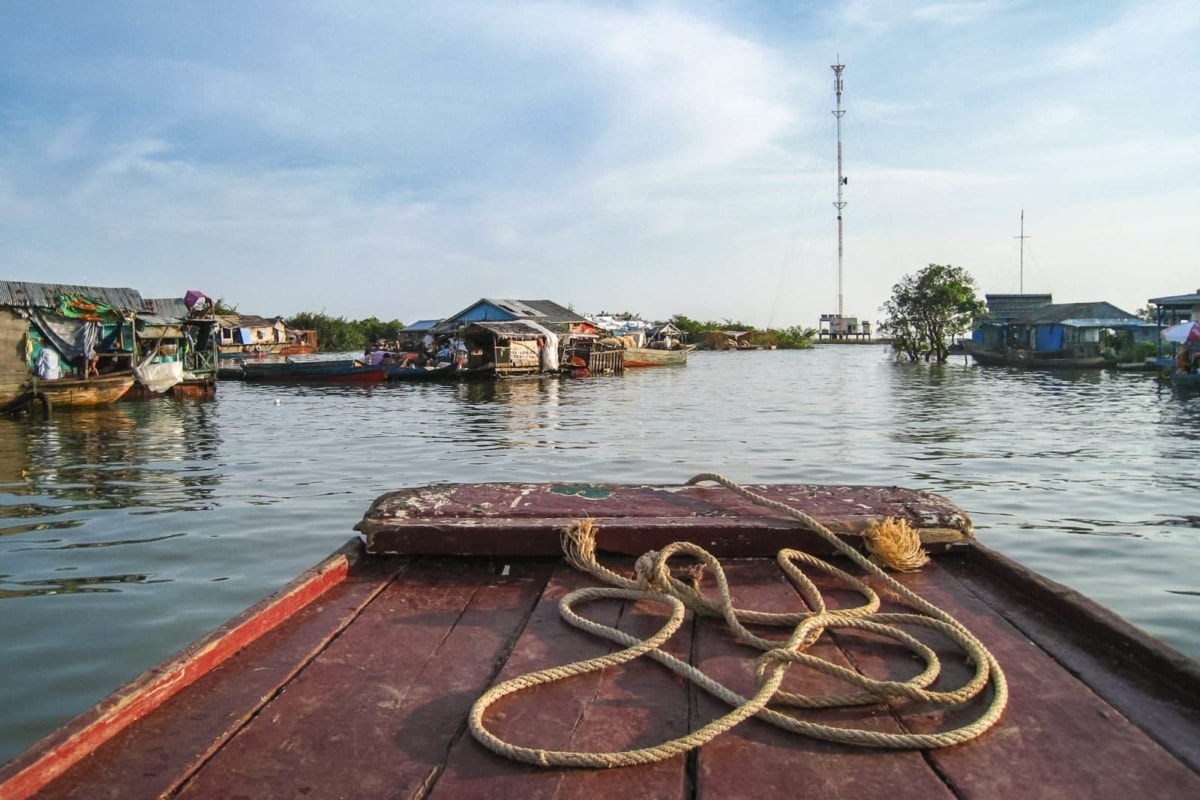
On board our vessel on Tonle Sap, making our way to the village, a ragged little motorized rowboat came up behind us. It appeared seemingly out of nowhere, like something out of a Jason Statham movie, and a small boy jumped on board with a box of candy and cans of soda, all on sale for a very good price, indeed.
This happened two or three times over until one boy actually jumped on board with a giant snake wrapped around his neck. He wanted to charge us a dollar to take his picture.
For some reason, everything in Cambodia costs a dollar and, as a white boy, I was always the one they wanted it from.
Poverty in the Floating Chongknease Village
We rode for a few minutes, gliding over the calm water, taking in the unique landscape around us. The guide explained that the village we were visiting was one of seven in the area, inhabited by more than 5,800 people in total. As the water levels would change throughout the year, the villages would be forced to relocate, meaning peoples’ houses were never in the same location. As they would move, certain sites would become more popular than others, and there were often disputes in the village over who would get to settle where.
In some ways, the village here was just like any other township. There were small restaurants and bars, floating schools and floating basketball courts where the children would congregate.
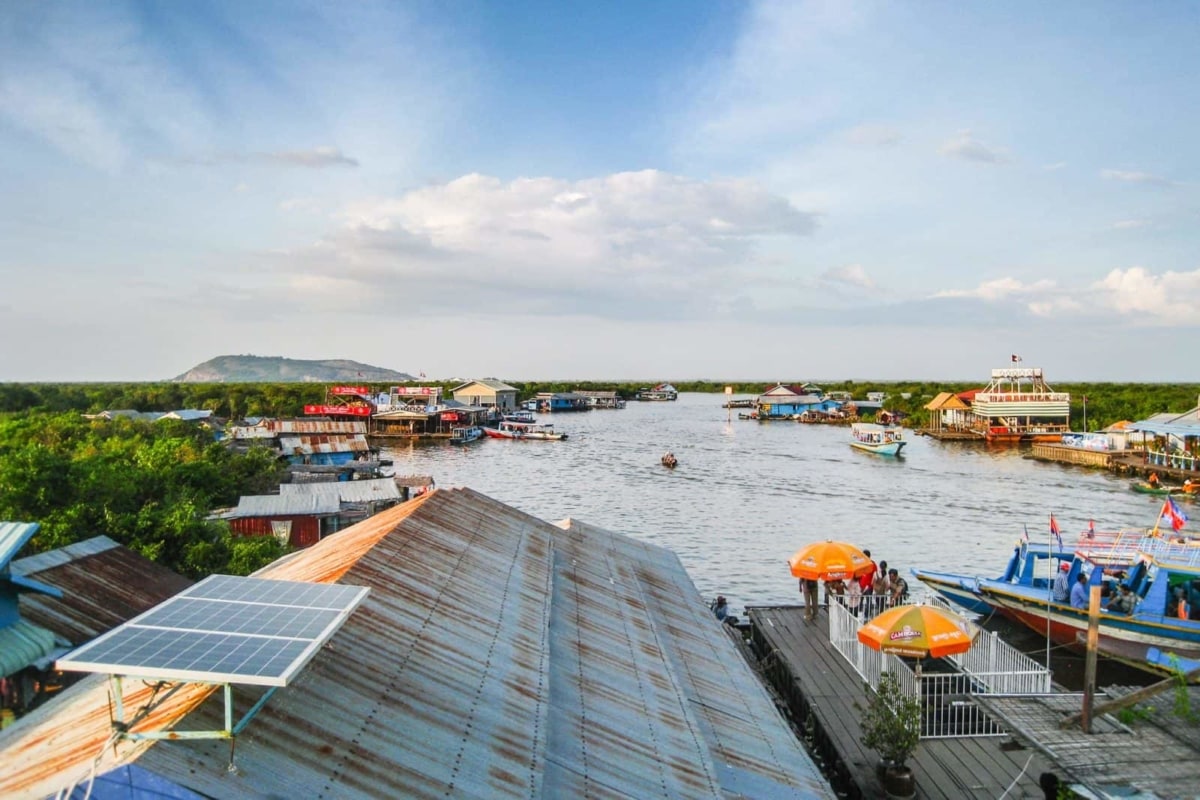
But my inquisitive mind got the better of me and, in trying to understand the way the people of Tonle Sap live, I began asking questions about their living conditions. I was informed that, due to the lack of power lines in the middle of a lake, every household used car batteries to power their cell phones and other electronics.
“But what about water?” I inquired. “Where does their drinking water come from? Do they bathe with water from the river? How do they wash their clothes?”
“It’s all the same,” my guide told me. “All of their trash, scraps, and waste become pollution in this water, which is the same water they use to drink and clean their dishes.”
It’s the same water they go to the bathroom in, the same water they clean themselves with, and the same water they drink to survive.
I was floored. Regardless of the prevalence of large charity organizations who raise awareness about clean drinking water in poverty-stricken areas, I had never quite wrapped my brain around the reality of the situation or come face to face with a people who literally did not have access to clean water.
Even in the Dominican Republic, we filled a bucket from a tap and poured the cold water over our bodies in the tub.
But these houses were floating on stagnant water. There were no pipelines or wells or irrigation systems. They had no choice but to eat their meals off dishes which had essentially been “cleaned” with their own fecal matter. Every. Single. Meal.
And, what was even harder to wrap my head around was the fact that the village had greater access to electronics like cell phones than they did to clean water.
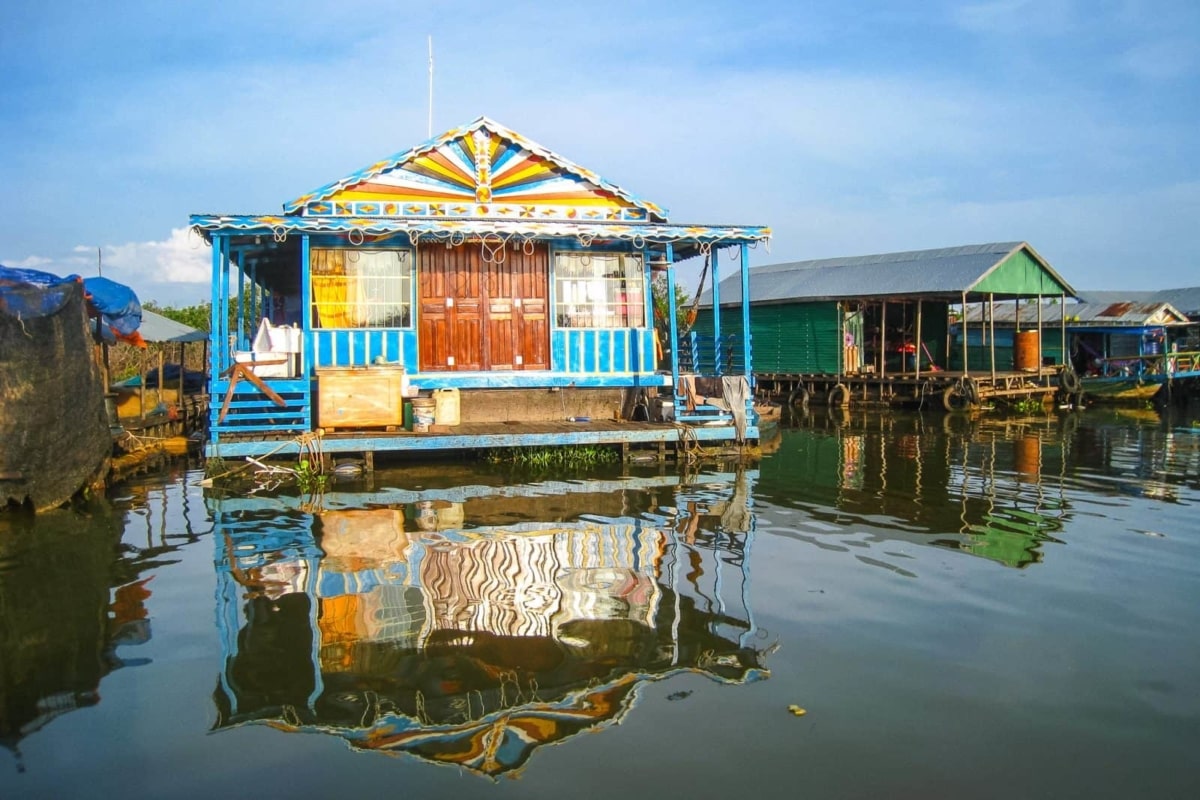
Local Residents Working Illegally
My visit to the floating Chongknease Village had unexpectedly become a rather eye-opening experience. I asked my guide about the locals’ jobs because I assumed that living in a floating village would greatly limit ones accessibility to the world beyond it. To no surprise, the men in the village were all fisherman. But, because there is a finite number of fish in a lake, in recent years, the government has begun to regulate their fishing.
The people of the floating villages have essentially been stripped of their only plausible occupation.
In response, almost every single family on the lake keeps traps under their house, away from the eyes of the government, and is forced to fish illegally just to make enough money to survive.
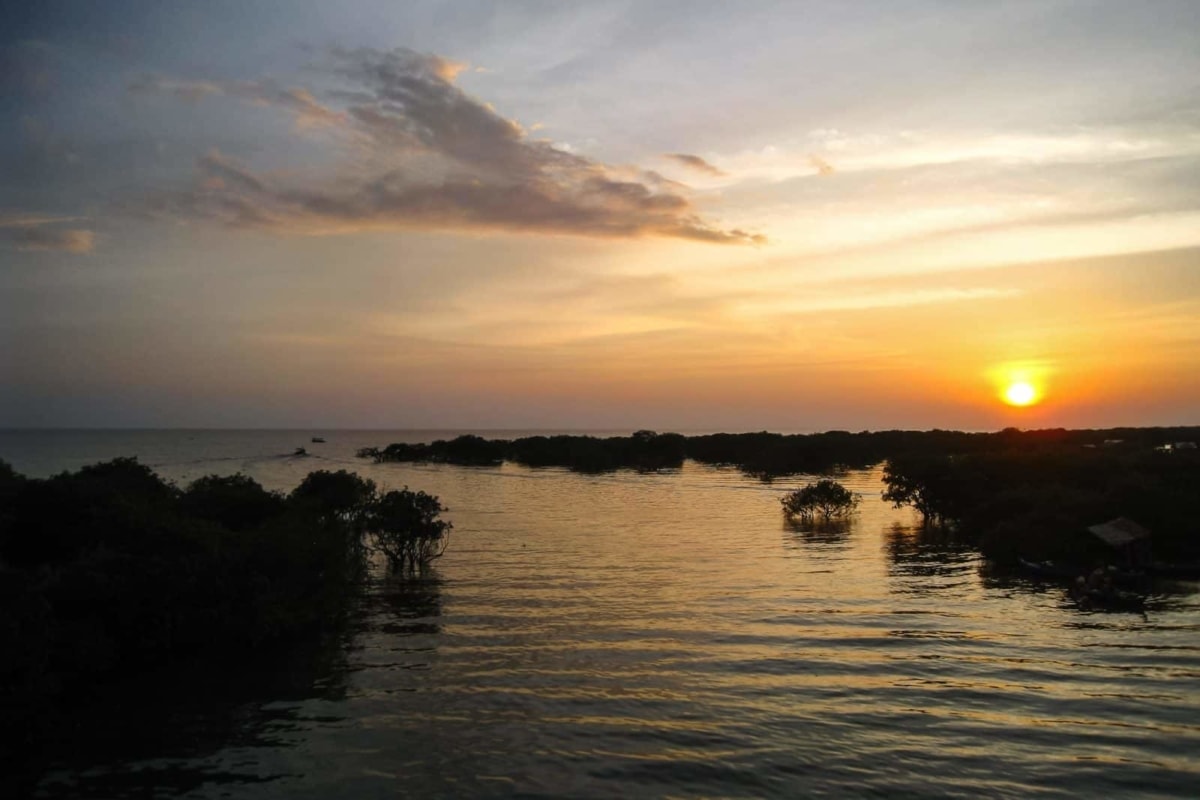
To top it all off, these people and their villages are essentially on display for people like me, the people who come to Cambodia to see what life is like in new countries, an incredible luxury that many world citizens are never afforded.
After having seen what I saw in the outskirts of Siem Reap that day, let us please never forget how lucky we are, and do our best to give back to the world in every way that we can.
READ NEXT: Volunteering in Cambodia: When Second Chances Change the World
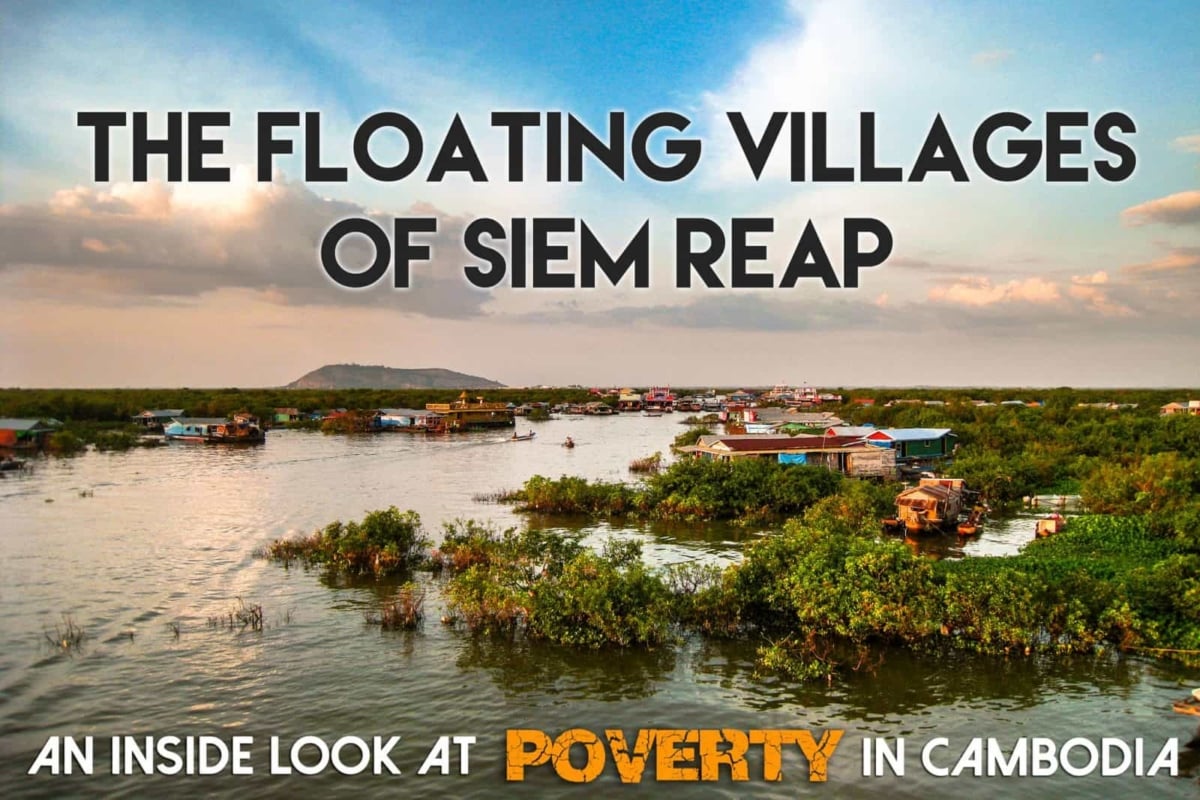

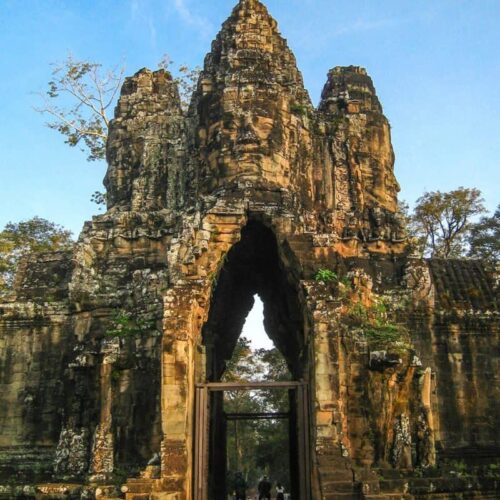
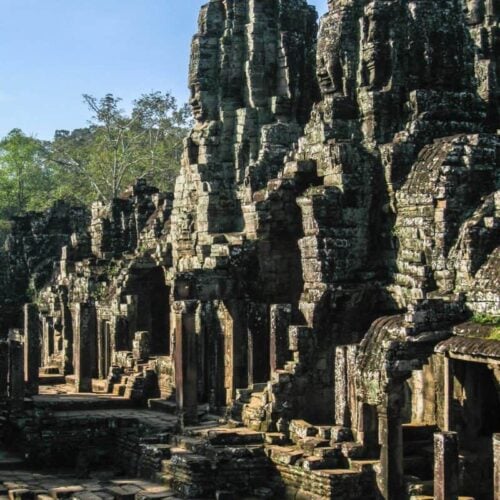
Wow, what an eye-opening and interesting read! I’ve seen extreme poverty before in India, but not to the point where communities have had no access to water. It definitely makes me grateful for growing up in New Zealand. I’ll be heading to Cambodia early next year and definitely be remembering the messages in this post, thanks
The line between poverty and tourism is heavily blurred in Cambodia. They are a third world country with millions of tourist dollars being spent there every year. It creates a very upsetting contrast, especially when, despite the influx of money, there are still people living without clean water.
I started to read this, then followed the link to your experiences in Laos and then came back and finished this entry. I found Cambodia incredibly depressing for the amount of poverty juxtaposed with corruption. We had to bribe our way into Cambodia, bribe our way through 3 weeks there and then bribe our way out. By contrast we had none of this in Laos where everybody was lovely and everything was priced and it just all worked. I left Cambodia thinking Laos would be worse for poverty and corruption and within minutes of crossing the border we were back on tarmac rather than dirt and there were petrol stations rather than children selling fuel out of recycled Pepsi bottles! When you consider the billions of tourist dollars spent in Siem Reap it just makes the poverty all even more depressing. One of the Cambodians we met said that government officials – such as border / immigration staff – have to bribe the government to keep their own jobs.
After Laos we went to back to Vietbam, my first visit after 6yrs away and that too was far more corrupt than I remember but that’s a different story and we had attempted overcharging and shortchanging every day for a month. But that’s a different story!
That’s really interesting. Of course, everybody has different experiences in different places, but I did run across plenty of corruption all throughout Southeast Asia, as it sounds like you did as well.
Some of the locals have gotten greedy and many travelers do not think about how they’re acting or spending when they’re in a new country. This creates a really horrible dynamic which breeds corruption and massive inequalities among the local residents.
I, personally, had a lovely time in Vietnam. Cambodia and Thailand were the two that really threw me off. But then again, it all boils down to experience.
Wow. Incredible. I always try and see how the local people live, and am often faced with extreme poverty. I recently saw extreme poverty in Guatemala, where families literally lived in a garbage dump.
Terrible :-\
To me, the worst part is that the organized tours from Siem Reap to the floating villages are run by people from the mainland who overcharge you (and possible scam you if you give them the chance) and that almost 0 money ever reaches the hand of the locals of the floating villages 🙁
And there’s almost nothing we can do about it, except not partake, or be very, very vigilant about vetting who you’re going with.
I knew some people that toured the floating villages near Siem Reap and it was basically a scam, they guilt tripped them into buying really expensive bags of rice then sold it back to the shops. I heard that happened a lot, not sure if it’s changed recently though.
To be fair, there are scams everywhere. Sometimes, avoiding those scams is just a matter of being safe and smart.
Doesn’t it shock you to see that this is how people live even today in some parts of the world? I always find it incredibly hard to wrap my head around the fact that we live in a world with such grave inequalities.
I think we forget about that sometimes. Or, even worse, we just choose not to recognize it.
Even with the town of Siem Reap a you weave through heading to the more remote temples everyone is on car batteries for their power and the poverty is palpable. We spent 2 months in Cambodia and it was one of the most eye opening experiences of our lives. It remians one of our favorite countries although after 2 months I wa ready to leave. The desperation is overwhelming, first world prolem though it is! Gratitufde and perspective definitely grew within us during those 2 months!
I’m happy to hear you had that experience. A lot of people turn a blind eye to it.
Ah, that’s heartbreaking. This happens in developing countries everywhere. There are not enough resources for everyone to enjoy what should be basic amenities. It seems the government has a pretty good reason for limiting fishing, but it’s unfortunate that these people have to be the ones to suffer. This is a complex problem that’s going to take a lot of time for the country to solve.
Assuming they choose to solve it at all. It seems that many of the people in Siem Reap are just trying to survive the day.
Makes us realise just how lucky we are
Suze | LuxuryColumnist
You mentioned in an earlier comment that “the line between poverty and tourism is heavily blurred in Cambodia”, and I couldn’t agree more. It was a difficult place for me to visit, because none of it is black or white. Cambodia made me very sad, and also made me feel quite helpless because with so much corruption in the country, it’s hard to find ways to help that will actually do good. 🙁 It worries me to think what the country will be like 10 or 20 years from now.
I wonder about that too. Saddening and maddening, isn’t it?
That is unfortunately a very sad reality, it’s incredible to think that nowadays there is still a huge gap between poor and wealthy people and it’s very painful to see how some of them have to live 🙁
Thanks for sharing this. We are in Siem Reap now, for a couple of weeks. I think this is something that would be educational for our kids to see as well. I can’t even imagine it. We are very lucky.
Hey Heidi,
It’s definitely eye opening, and could prove to be a valuable and eye-opening experience for your kids. Please just make sure that you visit responsibly 🙂
Hope you’re having a great time in Cambodia!
I had a similar experience at Kampong Khleang which wasn’t as touristy as the other villages but yes, I guess the level of poverty is pretty similar. It was a really good experience as well and the locals seemed quite happy with their lives even though I’m sure they probably are looking to improvements.
I think they have a really enlightened viewpoint which allows them to be happy. They’re just doing the best they can, and making the most of what they’ve got. It’s unfortunate how touristy these areas are, even if they do receive some commissions (it’s probably not a lot).
This experience sharing is absolutely happening in Siem Reap, Cambodia which is the country i was born at. Many poor people in Cambodia are still facing with clean water problem, education and poverty, and that is very sad when there is no one can give any guidance to farmers or poor people regarding to how to build good irrigation system and such. Some children do not have time to go to school as they are busy earning money or finding clean water. That is miserable.
Great read. I remember taking this boat ride through this village 5 years ago when I was in Siem Reap. However, I didn’t dig deeper into the background and situation of the village and water situation like you did. I’ve been in Thailand for the past 5 months or so and fair bit over the years. That sense of corruption that you allude to seems to be an ever hanging cloud when I’m in Asia. My sense 5 years ago was that Cambodia was on the verge of a tourism boom. But based on the infrastructure in place at the time, I wasn’t sure if they could handle a flood of tourism. Always enjoy reading your posts Jeremy. Are you going to be at TBEX this month inBangkok by chance? If so, hopefully see you there!
Unfortunately the village has been turned into a tourist attraction and there isn’t enough discussion about what life in the villages is really like. Some people tell me I ask too many questions, but sometimes it’s the only way. Cambodia actually has a pretty solid tourism infrastructure, as they see millions of visitors every year due to Angkor Wat. And I can only see it getting bigger…
I look forward to meeting you at TBEX!
I was just here. Definitely and eye opening experience. Nice post.
It’s a really interesting place. I’m glad you got to experience it!
Interesting read by all, i can confirm that things have not changed very much in regards to highly inflated cost of visiting the floating village (Siem Reap), guilt tripped into paying $50 US for a 10 kilo bag of rice , by the end of the day my anger had reduced somewhat when i considered the actual life the people were living ,And the resilience of the people , the smiles and laughter of the children , unaware of there parents daily struggle to put put a bowl of rice on the table . The corruption of the few to the woo of the many . to the look on the guides face when he felt his effort was not justly rewarded , by the amount of the tip given , to my feeling of guilt that i had come ill prepared for the extent of money i was expected to hand out , money i myself had not to give . Poverty all around me mess rubbish , stench , terrible injuries people sustained , young girls not at school looking after their siblings , And me staying at a resort stepping out for the day seeing a liitle and feeling guilty of the life i have .
Cambodia is a very sobering experience. Its considerable treasures are soiled by poverty, squalor and endemic corruption. When you see the horrors of the killing fields outside Phnom Penh juxtaposed with 200 thousand dollar cars driven by today’s rulers and privilged few – that and the posters everywhere touting the People’s Party – you can’t help but think that these gentle people have endured enough. That they deserve so much better. I would go back, but only to do something or contribute in some way.
Amazing blog with info about Cambodia and outstanding pictures! Really glad to find this amazing blog. Thanks for sharing with everyone and keep it up dear!
Thank you, Jesse!
I find it odd that the macaque monkeys aren’t mentioned in these different findings of “life” in Cambodia! Angkor Wat is mentioned in maybe once? That story just mentioned Angkor Wat as one of the many tourist attractions as to NOT visit! Cambodia has some beautiful Temple’s! Plus it has the biggest range of forests (among other things) that are home to most of the World’s Monkey Population! Maybe because these are “poor” monkeys! The types that are used in labs to figure out how a “certain” medication” might function in a human! Lab testing & the use of “slave monkeys” because they can pick coconuts much faster than any human! Call attention to the atrocities! Then, stop it!!
Interesting perspective…definitely a ton of poverty but really unique – had never seen something like this before. I do feel like you got lucky as most people I talked to that went to Chong Kneas had a bad experience (including two girls that were basically scared into giving the guide $100 just to get back to land). I did some research ahead time and went via this non-profit tour called Community First Kompong Khleang and had a really positive experience. Not touristy at all and quite a raw experience. Definitely worth visiting the floating villages if you are in Siem Reap.
Thanks for this information Jeremy! Its surprising to see a country which is growing in tourism industry have worst situation in some areas. This is ridiculous to see people drinking the same water which they use for toilet and to clean them self. Recently came across some very good articles which made me exciting to visit this place. Now, I am really not sure about this place.
Can you suggest another area where it is not so touristy…possibly a small village?
Thanks
What was the best way to ensure some of those villagers benefitted from being a tourist spot? I also like to go off the beaten path and see the reality of the countires I visit. I’d like to think they are not just on display, but would be wary of all that stemss from the stagnant waters? What is your advice. Do they sell goods or just food?
That’s a really good question, Jay, and I’m not sure I have an answer. The best way would be to donate to the elder or head of the village, but I couldn’t tell you how to do that ?♂️